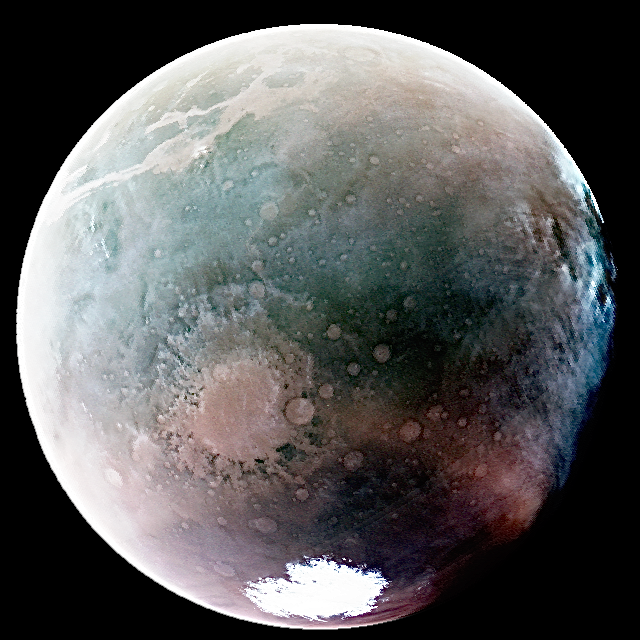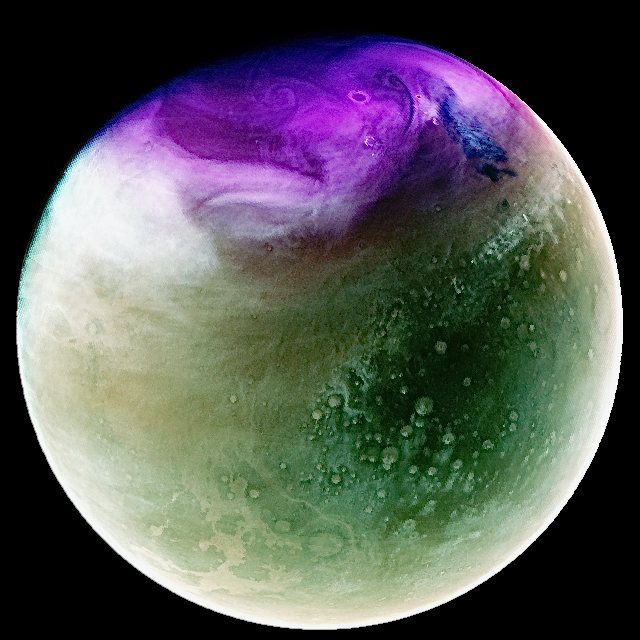NASA's MAVEN (Mars Atmosphere and Volatile EvolutioN) spacecraft has captured enchanting ultraviolet views of Mars, revealing stunning images of the Red Planet from different points along its orbit around the Sun.
The purpose of viewing Mars in ultraviolet wavelengths is to gain a deeper understanding of its atmosphere and surface features.
By using MAVEN's Imaging Ultraviolet Spectrograph (IUVS) instrument, scientists were able to obtain these global views of Mars during two distinct periods in 2022 and 2023, corresponding to opposite ends of the planet's elliptical orbit.

Ultraviolet Red Planet
The IUVS instrument measures wavelengths ranging from 110 to 340 nanometers, which fall outside the visible spectrum. To make these wavelengths visible and easier to interpret, the images are color-coded using varying levels of brightness for three ultraviolet wavelength ranges: red, green, and blue.
This color scheme allows scientists to distinguish different atmospheric components and surface characteristics. For example, atmospheric ozone appears as purple, while clouds and hazes appear white or blue.
The surface of Mars can take on tan or green hues, depending on the optimization of the images to enhance contrast and detail.

In July 2022, during Mars' southern hemisphere summer season, when the planet is in close proximity to the Sun, the first image was captured. This image captures the Argyre Basin, one of Mars' deepest craters, filled with a delicate pale pink atmospheric haze.
The picture also showcases the majestic Valles Marineris, a series of deep canyons appearing at the top left, enveloped in tan-colored clouds. At the bottom, the white southern polar ice cap is visible, diminishing in size due to the relatively warmer conditions of summer.
MAVEN's observations during this period provide valuable insights into the increased loss of hydrogen from Mars. This phenomenon can be attributed to the higher temperatures and dust storms, which drive water vapor to higher altitudes.
Read Also : NASA Perseverance Rover's Lightsaber Image Excites 'Star Wars' Fans; Here's What the Metal Tube Really Is
Far From the Sun
In January 2023, after Mars has reached the farthest point in its orbit from the Sun, the second image presents the northern hemisphere of the planet. This image captures the dynamic transformations occurring in the northern polar region, characterized by an abundance of white clouds.

The tan-colored Valles Marineris canyons and numerous craters create a captivating contrast. From the ultraviolet perspective, ozone exhibits a magenta hue, indicating its accumulation during the cold polar nights of the northern winter.
However, as the northern spring unfolds, chemical reactions with water vapor, which are confined to lower atmospheric altitudes during this time of year, contribute to the depletion of ozone.
Having been launched in November 2013, MAVEN successfully achieved Mars' orbit in September 2014. The mission's primary objective is to investigate Mars' upper atmosphere, ionosphere, and the intricate interplay between the planet and the Sun's solar wind.
Related Article : Mars 'Megatsunami' Came from a Massive Asteroid that Collided with the Planet 3.4B Years Ago

ⓒ 2026 TECHTIMES.com All rights reserved. Do not reproduce without permission.




